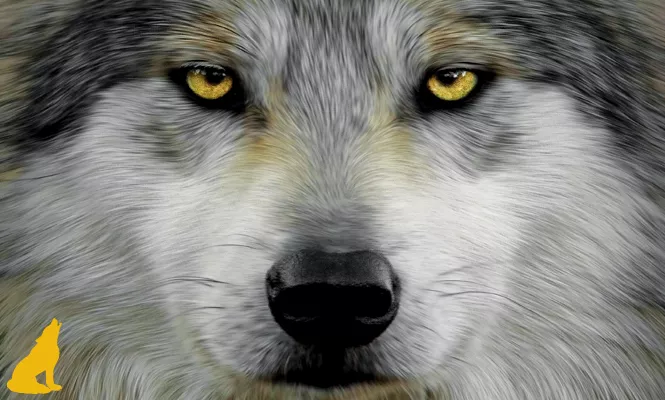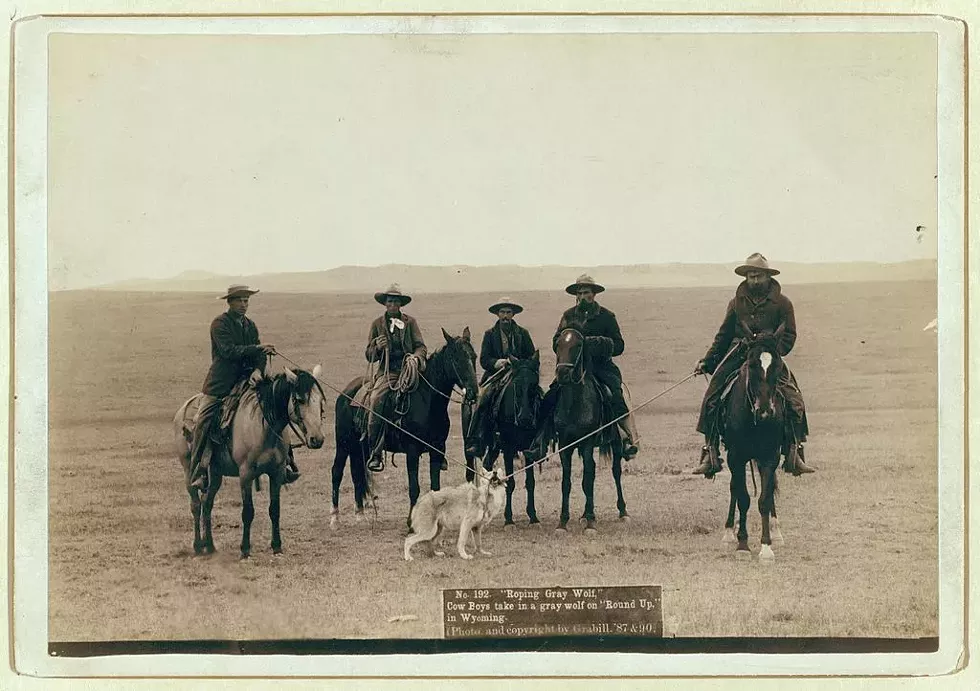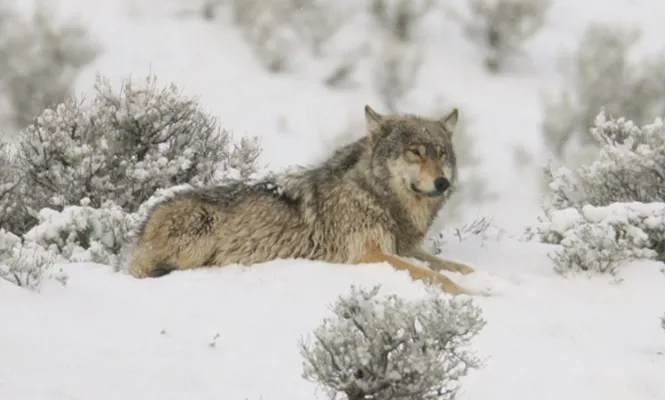
- Tim Monstrall
Last summer, the U.S. Department of Fish and Wildlife killed its first wolf from the Smackout pack after deciding that the animals were preying on too many cows in the state's Colville National Forest. The state's action came after its "Wolf Advisory Group" concluded that "lethal action" was the best way to manage the pack's population following a string of attacks on livestock on grazing allotments in the forest, despite the fact that numerous scientific studies have proven that livestock predation actually increases when wolves and other large predator animals are killed.
Almost 5,000 miles away, across the continental United States and Atlantic, a similar situation is playing out in Denmark. There, wolves have established a population for the first time in more than 200 years, thanks to reproductive success in nearby Germany. As in the western United States, the argument that wolves should be managed according to science is playing out against livestock-owner and hunting-industry desires to use lethal measures to stop the animals from preying on stock and game. It's a testy struggle—and one that has its origins in Europe itself.
"Wolves and other predator animals have been persecuted in Europe for hundreds of years by ranchers who want to protect their animals from attacks," says Hans Peter Hansen, a social scientist studying wolf policy at Aarhus University in Denmark. "Because today there are more people and more livestock, there is less room for wolves. And this has made it necessary for governments to 'manage' wolves, or ranchers might just wipe them all out."
Stateside, the contentious conversation is not a new one. In 2015, federal wildlife officials drafted a recovery plan calling for the reintroduction of the Mexican gray wolf after failed attempts in as many decades. Contesting Fish and Wildlife Service's credibility, all Four Corners governors—including Gary Herbert—sent the agency a letter saying they were "seriously troubled" by FWS' assemblage of "non-neutral" scientists who were adamant on expanding the lobo's range past its historic confines. Most notably, it spilling into Interstate 40, the highway that criss-crosses through Arizona and New Mexico. On and off, the conversation has continued. This past August, some 60 business leaders asked the federal government to release endangered Mexican gray wolves into the Grand Canyon area in northern Arizona and Eastern Utah.
The species' presence in the New World is as old as time. When settlers arrived in North America, they brought their livestock with them. This new presence of Europeans and their livestock led to the widespread and systematic persecution of predators in North America. By the early 16th century, chicken, cattle, horses, goats, sheep and pigs began populating farms in the American West, and colonists protected their livestock with guns. This, combined with hunters' thirst for wolf pelts, led to a massive decline in wolf populations. In some areas, wolves were completely wiped off the map.

- John C. H. Grabill Collection, Library of Congress
Today, ranchers in Europe and the United States are still dealing with wolves and other predators in much the same way as they did in the 16th century: They shoot them—or lobby government wildlife managers to shoot them—when the packs prey on livestock.
While killing wolves might give ranchers short-term peace of mind, it's more likely to plague them with long-term aggravation, according to the latest science. Researchers have found that killing wolves upsets pack dynamics—especially when young wolves are involved, like those in the Smackout pack—which leads ultimately to yet more livestock deaths. In one study, scientists found that for each additional wolf killed, the expected average number of preyed-on livestock increased by 5 to 6 percent per herd for cattle and 4 percent for sheep.
Fewer wolves also mean an increase in the number of prey they used to hunt, which can create a whole new set of problems. In particular, hooved wildlife such as elk and deer can overpopulate in a given environment. When there are too many of these hooved animals, plant life becomes overgrazed and entire ecosystems begin to fray. Unsurprisingly, livestock also contribute to overgrazing.
Further compounding wolf-management quandaries are European and U.S. policies that allow for livestock grazing, with permits, on public lands—the same public lands where wolves live. Wildlife managers encourage ranchers not to kill wolves indiscriminately, but instead try using livestock guardian dogs, fences and alarms, lights and nonlethal ammunition. The key to effective nonlethal predator control involves a variety of tactics to keep wolves on their toes; it also requires "thinking like a wolf," according to a recent Defenders of Wildlife report on the subject.
While nonlethal forms of predator control can help keep wolves at bay, in many cases—including the Smackout Pack study—that isn't enough to stop livestock predation, according to Brenda Peterson, author of the new book Wolf Nation: The Life, Death and Return of Wild American Wolves. "Despite whatever nonlethal measures may have been being employed to prevent conflicts between the wolves and livestock, it's clear that with a sustained proximity like this, the cattle should be moved elsewhere," Peterson says. "The land where the cattle are being grazed is public lands, and the livestock owner has a permit to graze there—it is a permit, not an absolute right. From the facts we know at this point, it appears that alternative grazing locations should have been identified and the cattle relocated."
Instead of forcing grazing allotment moves, the Wolf Advisory Group has agreed to kill off some of the Smackout pack wolves, a situation similar to that which played out last year in Colville National Forest when Washington's Department of Fish and Wildlife killed off seven of 11 of the wolves in the Profanity Peak pack, which had also been preying on livestock. Peterson says the park has lots of downed trees, allowing the cows to spread out and make them vulnerable to predation.
Denmark's wildlife managers face a similar situation: Ranchers are complaining that nonlethal measures to keep wolves from the country's new pack—of six wolves—away from livestock aren't working. So they're considering the same type of management that's being used in the United States, with one significant difference: It will be based on science, Hansen says. "We would make biologists' voices prominent during meetings," he adds. "Such experts can provide rural communities that might be afraid of wolves with facts that can help people understand why it's important to have wolves."

- Jeff Keeps
In the American West, some wolf advocates criticize the Wolf Advisory Group, accusing it of ignoring the best science when it decided twice in the past year to slaughter wolves. One of these advocates is Amaroq Weiss, West Coast wolf advocate with the Center of Biological Diversity. Weiss is a biologist and former lawyer who assesses conservation-agency actions and policies to ensure they fall in line with state and federal laws and follow the best available science.
"Wolf advisory groups that are established by state agencies do not have as a goal enforcing the law or following the best available science," Weiss says. "Their goal is to reach social compromise."
I witnessed this conflict first hand last summer when I backpacked for a few days across Gila National Forest to look for Mexican gray wolves, which have a controversial history in the West. After long-term, cooperative efforts to bring these wolves back from the brink of extinction, federal wildlife officials are tasked with releasing captive-born wolves into states that don't want them, namely Arizona and New Mexico. While entering and exiting Silver City, which leads to the forest, I encountered large billboards and road signs opposing wolves' very existence. "No, no, no wolves," one proclaimed.
I found plenty of deer, elk and cattle in the forest, but no wolves. Maybe that's not surprising: Only 113 wolves currently live in the Arizona and New Mexico wilderness. In recent years western state agencies updated a draft recovery plan for the wolves that conservation groups criticize as insufficient because it defines "recovery" as establishing "adequate gene diversity" among the population—once 22 captive-bred wolves are released and reach breeding age in a given geographic area. But it doesn't measure whether or not a wolf breeds once it reaches reproductive age, according to conservationists.
And, as illustrated by the situation in Denmark where all the new wolves are migrants or descendants of migrants, these canines can easily cross geographic lines. So limiting Mexican gray wolves—or any other wolf populations—to a specific area is virtually impossible. This complicates the politics of wolf management, which in the United States is largely delineated from the Fish and Wildlife Service to states and community advisory groups. That legal structure pits the people who want to get rid of wolves against the people who want to save them, and sometimes ignores the best available science that should be used to guide wolf management.
Perhaps the West should look at Hansen's goals for inspiration. "We live in this world of Trumpism—that all too often ignores the facts," he says. "For past 15 years I have worked to create spaces to give all people a say on an equal level to deliberate with each other with all the facts on the table. And strange things happen. People who can be the most destructive voices in the public debate, who exercise distorted communication change and become responsible, grow with the task. It's encouraging, something we need to explore much more."
A version of this article was originally published in The Revelator.
The Latest
In early December, the wildlife agency finalized a $178 million recovery plan designed to increase wolf numbers to about 320 in Arizona and New Mexico, plus 200 in northern Mexico, improving genetic diversity so wolves can be delisted. Environmental groups, arguing that the states' demands are trumping sound science, support the 2012 goal of 750 in the U.S. Biologist David Parsons, the first recovery coordinator, told the Arizona Daily Star that the new plan "is more likely to cause the second extinction of Mexican gray wolves in the wild than to secure their recovery."

- Jeff Weymier
Beasts in the Beehive?
One expert thinks the species would thrive in Utah.
The endangered Mexican gray wolf isn't welcome in Utah.
State officials made that clear in 2015.
Locally, the Mexican Gray Wolf's history—if it even had one—is a bit of, you guessed it, a gray area.
In late November, the U.S. Fish and Wildlife Service released its updated recovery plan for the wolf. The plan set the northern boundary for the animal's recovery along Interstate 40 in Arizona and New Mexico, effectively keeping the wolf from reaching any part of Southern Utah. If the wolf strays from that line, plans are in place for the wolf to be relocated.
Jeff Humphrey, spokesperson for the FWS Southwest Region that covers Arizona and New Mexico (Utah is in the Mountain-Prarie region), says determining that boundary came down to one question.
"Historically, where did the Mexican gray wolf occur?" Humphrey asks. "We've determined a pretty conservative estimate is [south of] Interstate 40."
The agency used input from scientists, genetic models, state fish and wildlife bureaus as well as specialists in Mexico to help determine that line, Humphrey says. The finalized recovery area includes Mexico, as well as the southern sections of Arizona and New Mexico.
The boundary, though, had its critics. And many, including those in Utah, questioned the FWS process as far back as 2011. Then came the 2015 letter from Gov. Gary Herbert and the other Four Corners governors expressing their concern of the wolf's population zone.
The states, according to the letter, claimed, "Available science does not suggest that areas north of I-40 were historically occupied by Mexican wolves."
Some genetic modeling, Humphrey says, indicates at some point, however, the wolf could have reached as far north as Nebraska. That wasn't going to fly with the new recovery plan. As of the last count conducted in January 2017, 130 Mexican Gray Wolves live in Arizona and New Mexico while 30 to 35 live in Mexico. The next count will be conducted later this month.
Wolves have lived in Utah. However, most of the continental United States' wolf population was decimated by federal hunters in the 1930s, and as a result, wolves were no longer a factor in the state.
Occasionally, wolves are sighted in Utah near Idaho and Wyoming. There were multiple sightings of the animals in fall 2014, according to a Salt Lake Tribune article. And in 2016, DNA tests confirmed an animal that was killed in a trap near Randolph, Utah, was a gray wolf.
The type of wolf that inhabited Utah before the 1930s likely is now extinct. Whether it was a subspecies or relative of the Mexican gray wolf also is up for debate.
The fact wolves, Mexican gray or not, were living in Utah at some point, though, means there is some scientific justification for allowing them back in the Southern Utah area, says Michael Robinson, an advocate with the New Mexico-based Center for Biological Diversity. The environment, he says, could support a wolf population.
Robinson says he hopes conservationists and wildlife officials who want the Mexican gray wolf to thrive don't just look at where it used to live, but determine what it's going to take for it to survive.
"There can be a wrong answer with, 'How do we save this animal from going extinct?'" Robinson says. "But the right answer almost certainly does involve recovery of Mexican wolves in Southern Utah.
"That's a no brainer they could survive there."
The Grand Canyon ecosystem, which includes parts of southern parts of Utah, he says, would be beneficial—a natural domain, even—to the wolves but the current plan limits that recovery.
Wildlife agencies also have to worry about other animal populations. Any introduction of another predator, such as the Mexican gray wolf, would complicate things.
"The state game and fish agencies have a tremendous concern over being able to manage their elk and deer population," Humphrey says. "That's the bread and butter for state agencies."
The current recovery plan will take decades to determine its effectiveness and the current boundary likely won't change before then. For those who want the wolf to grow in numbers, such as Robinson, they hope eventually that geographic area will grow as well.
"I believe that people in Utah are ready to open their hearts—obviously there are some that aren't —for a gravely imperiled animal," Robinson said. "It's a beautiful, intelligent social animal and it deserves a place in the Southwest including where it can survive in Southern Utah."